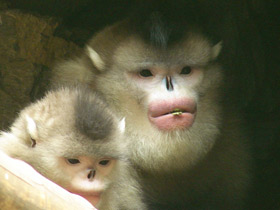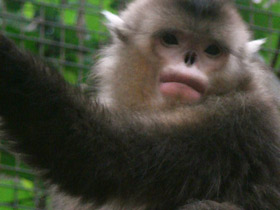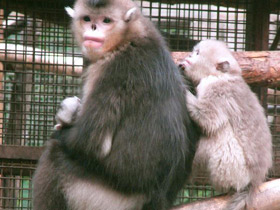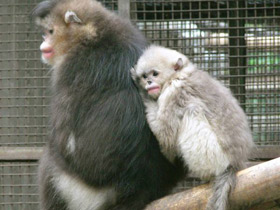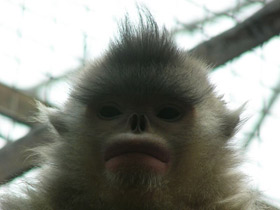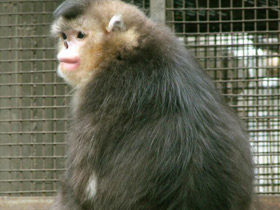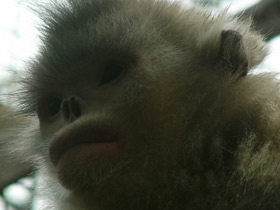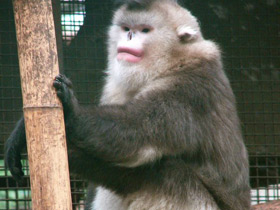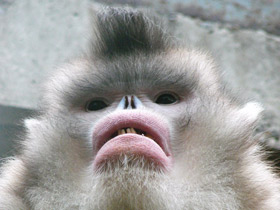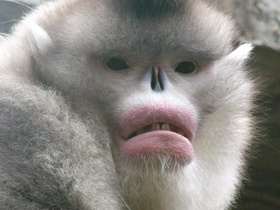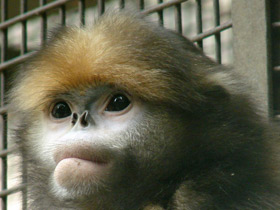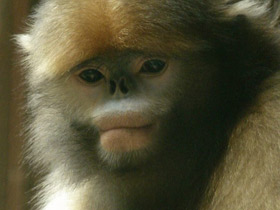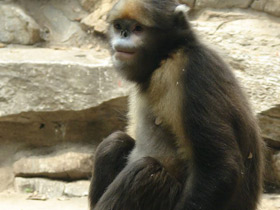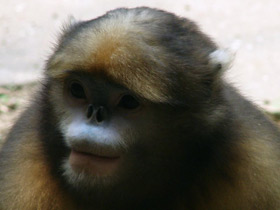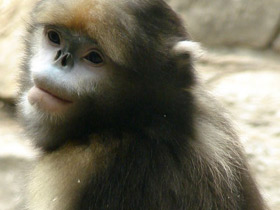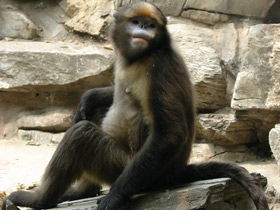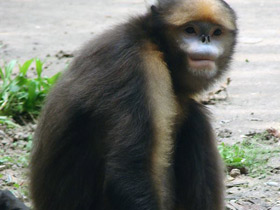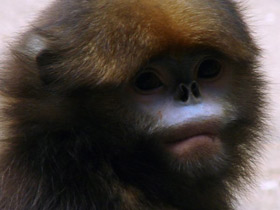The black-and-white snub-nosed monkey (Rhinopithecus bieti), the Yunnan snub-nosed monkey
The black-and-white snub-nosed monkey (Rhinopithecus bieti), also known as the Yunnan snub-nosed monkey, is a large black and white primate that lives only in the southern Chinese province of Yunnan, where it is known to the locals as the Yunnan golden hair monkey (滇金丝猴) and the black-and-white snub-nosed monkey (黑白仰鼻猴). The common name, black snub-nosed monkey, is issued to Rhinopithecus strykeri, inhabiting the Northern Sino-Myanmar border. Coniferous and deciduous forests in the mountainous regions of Yunnan are the ideal terrain for these primates. It is threatened by habitat loss, and is considered an endangered species. With their unique adaptations to their environment, these monkeys thrive at extreme altitudes despite the below freezing temperatures and thin air. This primate's diet is mainly made up of the large amounts of lichens available in their region.
Description
Rhinopithecus bieti is a species of catarrhine primate in the family Cercopithecidae. Rhinopithecus bieti is endemic to mainland China. The species is considered endangered due to habitat destruction and is one of the least studied primate species. The difficulty of research is mainly due to its semi-nomadic lifestyle and its secretive and inaccessible range.
The species is named in Latin after the French missionary Félix Bieu (1838-1901).
Rhinopithecus bieti is a rather large ape with thick black fur on the back and limbs and white on the lower body. The fur on the sides is also white, especially long in adult males, and on the shoulders it is yellow-grey. The lips of this amazing ape are pink, the face is pale and the nostrils are upturned. The young are born white and in a few months the fur becomes darker. Adult apes have a body length of 51 to 83 cm and a tail of 52 to 75 cm. Males weigh 15-17 kg and females 9.2-12 kg.
Habitat area and social behaviour
The range of Rhinopithecus bieti is in an upland valley, extending from Tibetan Mancang County to Yunlong County in Yunnan Province in southwest China. Zoologists have found 13 isolated micro-populations of Rhinopithecus bieti.
These monkeys live in totally extreme conditions: in coniferous and mixed mountain forests at altitudes of up to 4,700 metres, higher than any primate species other than humans. Mountains are very cold: frost can reign there for 280 days a year. The snow cover in these places can be up to a metre high.
Of course, one cannot survive alone in these places, and rhinopithecines live in flocks of several dozen individuals. Each flock consists of family groups of one adult male with a harem of three to five females and their young. Sometimes large groups of up to 300 individuals are formed.
Unlike other monkeys, Rhinopithecus bieti feeds mainly on lichens. Lichens are known to regenerate very slowly, taking 10-15 years. Apparently, in order not to deplete its food supply, Rhinopithecus bieti must constantly migrate. These primates move relatively quickly and travel long distances in a day in search of food. The range of the swarm can be up to 25 km2, but can be much larger.
The reproductive rate is extremely low: females give birth to one offspring every three years.
Diet
Unlike many primates, the black-and-white snub-nosed monkey's diet consists mainly of lichen found on trees. Lichens grow in abundance in mountainous regions, and make for a reliable, year-round food supply. These primates will also eat bamboo leaves and other, more seasonal plants if the opportunity presents itself. Many food items vary depending on the geographical location of each troop including rhododendron flower's nectar in the spring. Lichens are toxic to most animals, but the black-and-white snub-nosed monkey has specialized digestive enzymes similar to those of a cow that remove the harmful bacteria.
Reproduction
The reproduction cycles of black-and-white snub-nosed monkeys are generally similar to those of golden snub-nosed monkeys, except the time of birth is often two to three months later due to a colder climate. Like most primates, the snub-nosed monkey gives birth at night, making it difficult for researchers to observe. A rare observation of a daytime birth found a multiparous female assisting another female in the birthing process, similar to human midwifery practice.
Evolution
The black-and-white snub-nosed monkey lives at the highest altitude of any known non-human primate. The highest recorded altitude of a group of this species is 4700 m. Surviving in such extreme conditions is only made possible by a mutation in the primate's genomic DNA sequence that allows increased resistance to oxygen deprivation (hypoxia). Other mutations in the DNA sequence have been found to be harmful to the monkeys, as there is evidence of inbreeding and low genetic diversity among populations.
Geographical range and habitat
This species has a highly restricted distribution in the bio-diverse Nujiang Langcang Gorge alpine conifer and mixed forests of the Yun Range, which is part of the greater Hengduan Mountains. Only 17 groups with a total population of less than 1,700 animals survive in northwest Yunnan and neighboring regions in the Autonomous Prefecture of Tibet. The territory of each group varies from 20 to 135 square km. Deciduous and coniferous forests are their preferred habitat, where lichen grows in abundance year-round.
History
The black-and-white snub-nosed monkey was almost completely unknown until the 1990s. The fact that no zoo outside of China has ever kept the black-and-white snub-nosed monkey in captivity has contributed to the enigmatic status of this species.
Rhinopithecus bieti in the Red Book
Little was known about Rhinopithecus bieti until the 1990s, when the first studies on its biology were carried out. In 1989, the species was already listed by the Chinese government as a Category I protected species. In 1996, Rhinopithecus bieti was included in the Red List of the International Union for Conservation of Nature with the status of "endangered". According to a survey conducted by the Zhongnan Forestry Research and Design Institute of the State Forestry Administration, the population of the named monkey species in Yunnan Province is less than 1,000, while Tibet is also home to about 1,000 monkeys.

















